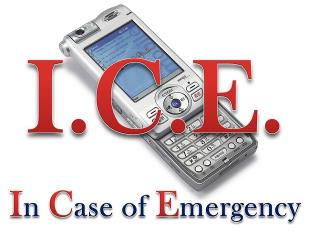

In case of an emergency, how would the police or paramedics know who to contact?
In an emergency, hospital staff or emergency services often waste valuable time searching through wallets and cell phones to determine which numbers to call.In Case of Emergency (ICE) CampaignHere is how it works:Store the word “ICE” into your cell phone’s contact list followed by the phone number of the person you wish to be contacted “In Case of Emergency”. For more than one emergency contact, enter them as follows: “ICE1” , “ICE2”, “ICE3”, etc…Sometimes emergency services can’t find an ID on the patient so when they try to notify next of kin, they have no name to give them nor will they know who they are calling. Consider entering the names as follows:ICE1 Bob’s (Wife)ICE2 Bob’s (Father)ICE3 Bob’s (Doctor) |
ICE4 Bob’s (Work)Suggestions:1. For cell phones belonging to children, make sure the ICE contacts include parents or guardians (those able make medical decisions on there behalf).2. Make sure you request permission from those you intend to use as your ICE contacts.3. Use phone numbers for your ICE Contacts that they are most likely to answer (i.e. cell phone, instead of home number).4. Make sure your ICE contacts have a list of other important phone numbers and is familiar with your medical conditions, allergies, and prescriptions. |
|
I.C.E. (In Case of Emergency) |


